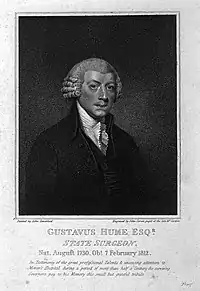Gustavus Hume
Gustavus Hume (1730[1] – 7 February 1812) was the president of the Royal College of Surgeons in Ireland (RCSI) in the first part of 1795. He specialised in the diseases of children. He was one of the surgeons who examined the body of the journalist William Jackson after he died from poisoning in a Dublin court in 1795 while awaiting sentencing for high treason.
Gustavus Hume | |
|---|---|
 | |
| Born | 1730 United Kingdom |
| Died | 7 February 1812 (aged 81–82) Dublin, Ireland |
| Nationality | Irish |
| Occupation | Surgeon |
Early life and family
Gustavus Hume was born in 1730 to a family of Scottish origin, some of whom settled in Ireland in the seventeenth century. His father was Robert, and his grandfather was Thomas Hume, of Humewood, County Wicklow, who was an ancestor of the Irish Conservative politician William Wentworth Fitzwilliam Hume-Dick.[2]
One of Hume's sons was the physician Thomas Hume (c. 1769–1850)[3] and his great grandson was Lieutenant Colonel Sir Gustavus Hume[2] (1826–1891) who served in the British Army during the Crimean War.[4]
Career
_p049_THE_COLLEGE_OF_SURGEONS.jpg.webp)
It is not known to which physician Hume was apprenticed. In 1758, he was living in Longford Street, Dublin, when he was appointed surgeon to the Mercer's Hospital. He developed a successful practice and specialised in the diseases of children. He liked to prescribe oatmeal porridge and as a result received the nickname "Stirabout Gusty" which was referred to in William Norcott's The Metropolis as follows:[2]
- "H-me, twice as ancient as the College Charter,
- Scours Death with Stir-a-bout from ev'ry quarter."
Hume was an early member of the Board of Examiners for Surgeons to County Infirmaries. He did not join the Dublin Society of Surgeons, but was one of the censors named in the first charter of the Royal College of Surgeons of Ireland.[2] In 1791, he and Clement Archer jointly became State Surgeon in succession to John Neill.[6]
Together with Dr Adrien, Hume examined the body of the journalist William Jackson in the dock of the King's Bench, Christ Church, on May Day 1795, after Jackson died from poisoning while awaiting sentencing for high treason.[2]
Hume was president of the RCSI only from January to 4 May 1795, resigning on that date for reasons that are unknown but which Cameron writes probably related to the case of the former member of the society, Frederick Drury, who was expelled for giving false testimony in court. Drury sued for reinstatement and failed but significant legal costs were incurred which the society tried to recover from Drury.[2][7] Vice President Clement Archer was elected in Hume's place.[2]
Hume's medical writings were on the subjects of the diseases of children, angina pectoris, cowpox, and gout.[2]
Building
Hume built a number of houses. In 1770, he built number 5 Ely Row (previously Hume Row).[8] He built a mansion in Merrion Square, east, which was later divided into two large houses, in one of which Sir John Banks, physician to Queen Victoria, lived.[2] He built a home for himself at 63 Dawson Street in which he died.[9] In 1775, John Gilborne wrote of Hume:[2]
- "Gustavus Hume in Surgery excels,
- Yet Pride of Merit ne'er his Bosom swells;
- He adds to Dublin every Year a Street,
- Where Citizens converse and friendly meet."
Death
Hume died on 7 February 1812.[2]
References
- https://commons.wikimedia.org/wiki/File:Gustav_Hume._Stipple_engraving_by_J._Carver_after_J._Comerfo_Wellcome_L0005724.jpg
- Cameron, Sir Charles A. (1886) History of the Royal College of Surgeons in Ireland, and of the Irish Schools of Medicine &c Dublin: Fannin & Co. pp. 323–25.
 This article incorporates text from this source, which is in the public domain.
This article incorporates text from this source, which is in the public domain. - Goodwin, Gordon (1891). . In Lee, Sidney (ed.). Dictionary of National Biography. 28. London: Smith, Elder & Co. p. 235.
- Captain Malet and Colonel Hume. The Library of Nineteenth-Century Photography. Retrieved 12 May 2018.
- Dublin Delineated in Twenty-six Views, etc. Dublin: G. Tyrrell, 1837. p. 49.
- Cameron, p. 106
- Cameron, p. 132 & pp. 138–39.
- McCready, C.T. (1892) Dublin Street Names, Dated and Explained. Dublin: Hodges, Figgis, & Co. p. 52.
- Cowell, John. (1996). Dublin's Famous People and where they Lived. O'Brien Press. p. 91. ISBN 978-0-86278-468-3.
| Wikimedia Commons has media related to Gustavus Hume (surgeon). |